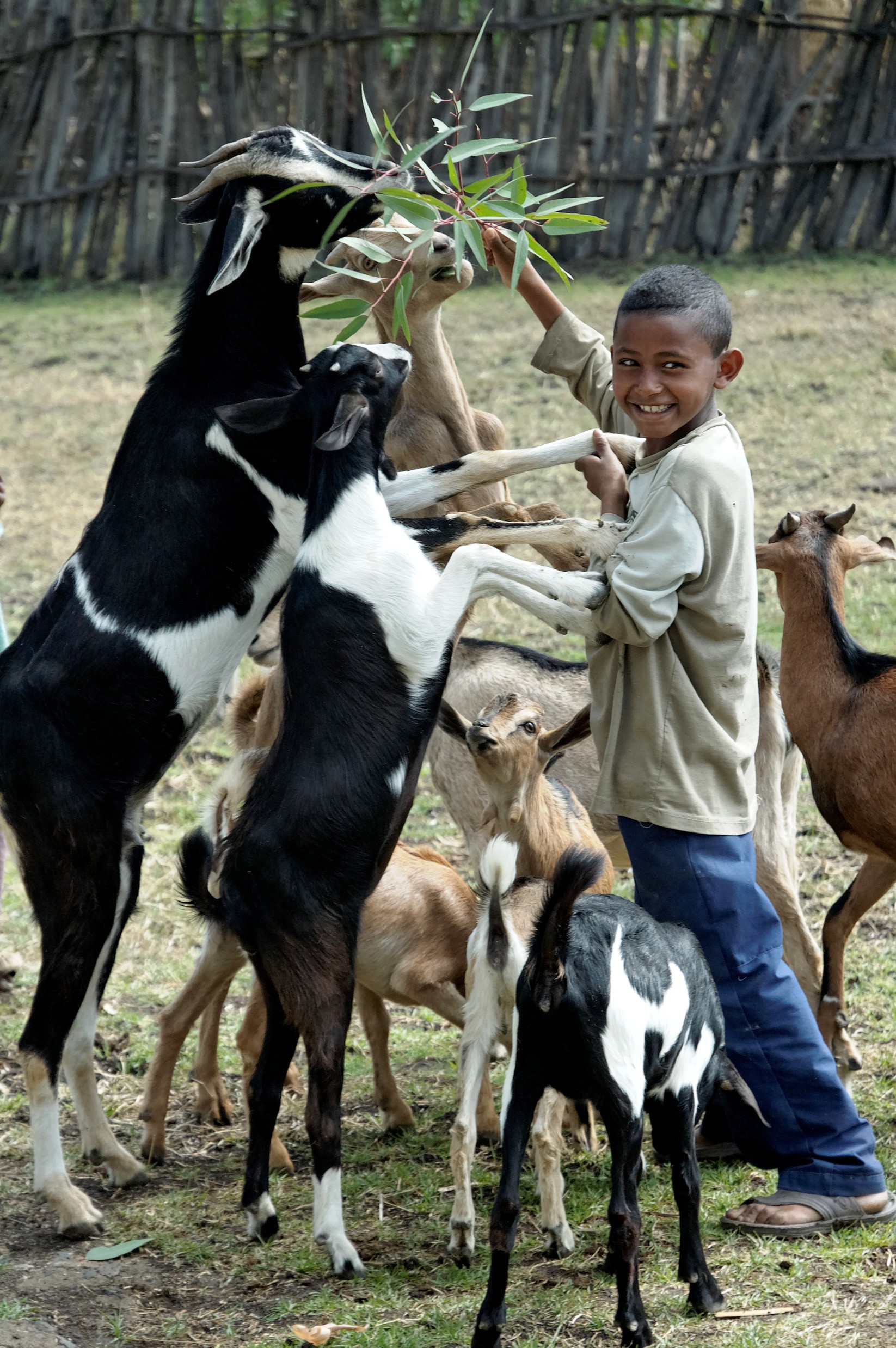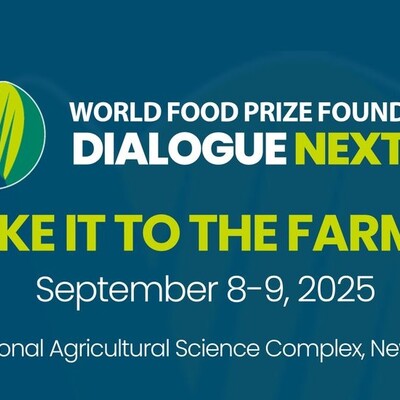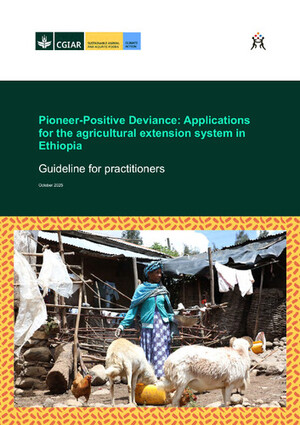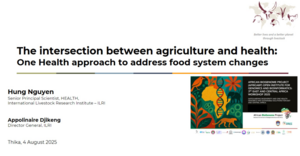
Animal health experts on the ‘goat plague’ known as PPR chart ways forward for better controlling a widespread disease harming the world’s small-scale sheep and goats producers

A boy feeding goats during the SLP crop residues project field trip to Ginchi in Ethiopia (photo credit: ILRI/Bruno Gerard).
Peste des petits ruminants (PPR), also known as ‘goat plague’, is a viral disease related to rinderpest of sheep as well as goats. This contagious transboundary disease hurts the livelihoods of millions of small-scale livestock farmers, threatening food security with estimated economic losses exceeding USD1.5 billion per year. The disease threatens 80 per cent of the global sheep and goat population in over 70 countries in Africa, Asia, Europe and the Middle East.
In 2015, the Food and Agriculture Organization of the United Nations (FAO) and the World Organisation for Animal Health (OIE) jointly developed and endorsed a global strategy for the control and eradication of PPR. The strategy, which is an inclusive rather than ‘stand-alone’ activity, was designed to globally control and eradicate this plague as well as to help scientists progress in other research areas that would strengthen veterinary services, which is a cornerstone of the strategy. Lessons learned from eradicating rinderpest from the world eight years ago, and from numerous regional animal disease experiences have been absorbed in this new work to eradicate goat plague from the world. (Rinderpest was an infectious disease of ruminants animals, and cattle especially, caused by a close cousin of the virus that causes goat plague.)
Global researchers and experts in the field of peste de petits ruminants have developed a network known as PPR-GREN. These individuals first gathered in 2018 to discuss potential diagnostics and vaccines for this disease and the socioeconomics, transmission and impacts of wildlife on this disease, which causes fever, mouth sores, diarrhoea, pneumonia and sometimes death.
This year, 13-15 November 2019, more than one hundred researchers gathered in Nairobi, Kenya, at the International Livestock Research Institute (ILRI) in a three-day meeting to report on progress that has been made in these areas and to determine next steps through recommendations.
The science of peste des petits ruminants
In the room full of experts from around the globe, presentations were given on research undertaken to better control goat plaque. The main research areas addressed were on the epidemiology, ecology and socio-economy of this disease, development of laboratory tests to diagnose it, the state of progress in production of a vaccine against it and outreach, advocacy and communications work needed to better control it.
Participants heard that the French Agricultural Research Centre for International Development (CIRAD) is involved in several research activities highlighted by PPR GREN, such as understanding the role of the wildlife in PPR epidemiology and developing risk maps of spillovers of the disease spreading from livestock to wildlife. Other research activities discussed included full-genome sequencing of West African field strains of the causative virus; the risks of cross-reactivity using (ELISA-based) diagnostics; the possible establishment of an OIE PPR lab network; and PPR vaccine research, including strain attenuation using a conventional vaccine (Nigeria 75/1) and development of new-generation vaccines.
Amanda Fine, the wildlife health program associate director for the Wildlife Conservation Society, argued the need for better understanding of virus epidemiology at the wildlife-livestock interface to support the integration of wildlife into PPR eradication efforts.
Jingyue Bao shared updates from the China Animal Health and Epidemiology Center, which is one of the OIE reference laboratories for PPR. The center is developing novel diagnostic assays for detecting PPR viruses, establishing ‘reverse genetics’ methods for the virus vaccine strain, and exploring the evolutionary dynamics of the virus epidemic in China, which suggests that long-distance animal transmissions play an important role in the spread of the virus in China.
Recommendations from the working groups
The participating researchers engaged in interactive discussions by four working groups addressing:
- Atypical domesticated host species
- Vaccine strategies, targets and delivery mechanisms
- The socio-economics of the disease
- The role of wildlife in eradicating the disease
Some recommendations included broadly developing cross-country data-sharing platforms, which would include sharing standardized protocols allowing cross-border collaborations at the wildlife-livestock interface. The vaccine strategy group had several recommendations, the primary one being to develop a resources group that can validate the vaccination programs of various players. Other recommendations included investigating alternative surveillance options, the impact of employing combined vaccinations or treatments vs. PPR only vaccinations and developing differential diagnostics for post-vaccination monitoring and reassurance. The participants called for increased understanding of disease transmission and persistence among the atypical domesticated animal host species of the causative virus of this disease, including cattle, camels and other camelids, pigs and other suids, and the Asian water buffalo and the African buffalo. This group of experts also called for improved diagnostics to detect virus exposure in these atypical domesticated species.
This meeting was held at ILRI and jointly organized by the Food and Agriculture Organization of the United Nations (FAO) and the World Organisation for Animal Health (OIE), in collaboration with the Africa Union Interafrican Bureau for Animal Resources (AU-IBAR) and ILRI. The meeting was launched by Principal Secretary Harry Kimtai in Kenya’s State Department of Livestock within the Ministry of Agriculture, Livestock, Fisheries and Irrigation.
‘Small ruminants are critical to our livelihoods, as is the role of women and youth in our global PPR eradication strategy. The forum held here today provides an excellent opportunity for experts from across the world to discuss the importance of wildlife and other animals as the reservoir for the virus, as well as to discuss the socio-economic impact of the disease.’
—Harry Kimtai (PS)
Adama Diallo, chair of PPR-GREN and senior researcher at the French Agricultural Research Centre for International Development (CIRAD), emphasized the need to discuss and identify research topics that may fill research gaps identified in the epidemiology of PPR, which includes the outcome of PPR infections of other animal species. ‘We need to understand the socio-economic impact of PPR and the impact it has on rural communities.’
Others who shared opening remarks included Henry Wamwayi, AU-IBAR representative; FAO’s director of animal production and health division, Berhe Tekola; OIE’s regional representative for East Africa and the Horn of Africa, Samuel Wakhusama; and ILRI’s deputy director general for biosciences, Dieter Schillinger.
The joint PPR secretariat, including Jean Jacque Soula, OIE PPR Coordinator, and Felix Njeumi, FAO PPR Coordinator, argued the importance of linking the eradication strategy to the Sustainable Development Goals: ‘A family without small ruminants simply doesn’t exist and we need to link the two with resilience,’ said Njeumi.
Soula said, ‘There is a strong and lasting international consensus on the goal to eradicate PPR. FAO and OIE are committed to this as demonstrated by a recent visit of both organizations’ directors general in Rome to commit to the eradication strategy by 2030. He further added, ‘Global-level coordination is needed, especially with the scientific community through PPR GREN to deal with issues of wildlife and socio-economics.’
The recommendations generated at this workshop were shared with the PPR Secretariat and FAO and OIE management.
Further information is available:
Concept Note PPR GREN second meeting, Nairobi, Kenya 13–15 Nov 2019
First phase of PPR global eradication effort taking shape
First meeting in Vienna (Austria), 17–19 Apr 2018: The Peste des Petits Ruminants Global Research and Expertise Network (PPR-GREN)
Beth Miller and Paula Menzies from the International Goat Association participation in the second meeting of PPR GREN in Nairobi



















